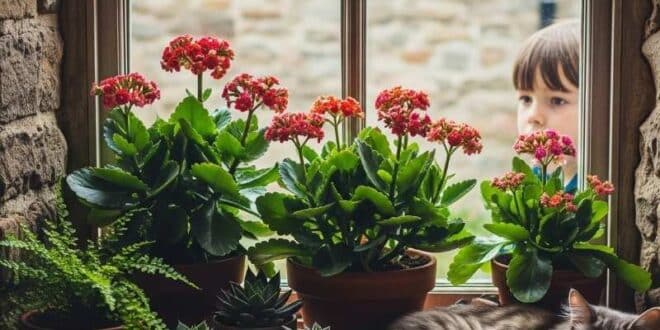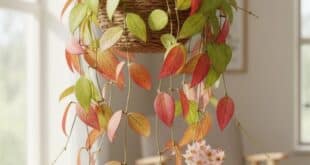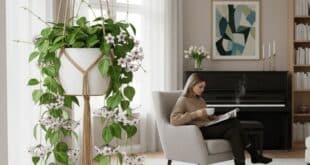Kalanchoe
Imagine a plant that gives you a burst of incredibly bright, long-lasting flowers, even during the cooler months, all while being wonderfully low-maintenance. Say hello to the Kalanchoe plant! This delightful beauty, often called Florist Kalanchoe or Flaming Katy (Kalanchoe blossfeldiana is its fancy name), is a true gem in the houseplant world.
Hailing from the sunny, dry landscapes of Madagascar, Kalanchoe brings instant cheer with its vibrant clusters of blooms and hardy, succulent leaves. It’s a fantastic choice for anyone who loves flowers but wants something easy to care for! Ready to brighten up your home with this resilient and colorful plant? Let’s uncover all the secrets to making your Kalanchoe absolutely flourish!
What Makes a Kalanchoe So Unique? Its Bright Blooms and Succulent Leaves
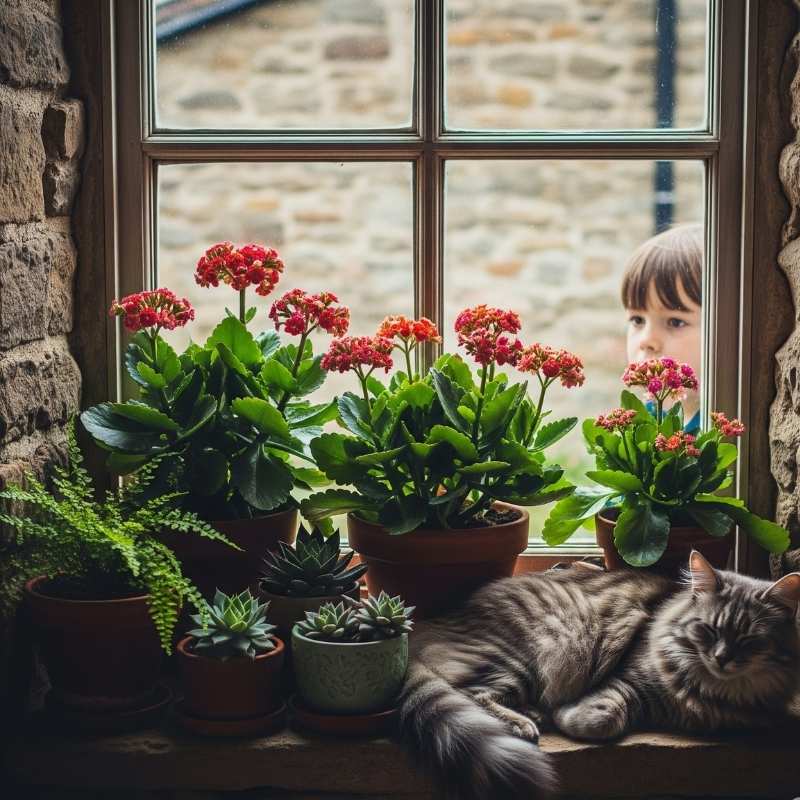
When you look at a Kalanchoe, you’ll immediately be drawn to its flowers! They’re usually small, with four petals, but they grow in incredibly dense, cheerful clusters that create a dazzling display of color. You can find them in almost every shade imaginable – fiery reds, bright oranges, sunny yellows, soft pinks, and pure whites. The best part? These blooms can last for weeks, sometimes even months, making them one of the longest-flowering houseplants!
Beneath the flowers, you’ll find thick, waxy, dark green leaves that feel a bit like rubber. These are succulent leaves, designed to store water, which is a huge clue about how little watering this plant needs!
Where Do Kalanchoe Plants Come From? Madagascar’s Sunny Hills
Your Kalanchoe’s ancestors originally come from the sunny, dry, and rocky hillsides and cliffs of the island of Madagascar, off the southeastern coast of Africa. Imagine a place where water isn’t always plentiful, and the sun shines bright! This background perfectly explains why Kalanchoes are natural succulents – they’re built to store water and love basking in the sunshine.
What Are Its Other Names? “Florist Kalanchoe” and Its Cheerful Appeal
The most common names for Kalanchoe blossfeldiana are “Florist Kalanchoe” (because florists love to sell them, especially around holidays due to their long-lasting blooms!) and “Flaming Katy” (especially for the bright red varieties, which look like little flames!). Their appeal truly lies in their ability to bring immediate, vibrant color and a cheerful, easy-going vibe into any space.
What Kinds of Kalanchoe Plants Are There?
While the flowering Kalanchoe (Kalanchoe blossfeldiana) is what most people recognize, the Kalanchoe family is actually quite diverse, offering a range of interesting leaf types too!
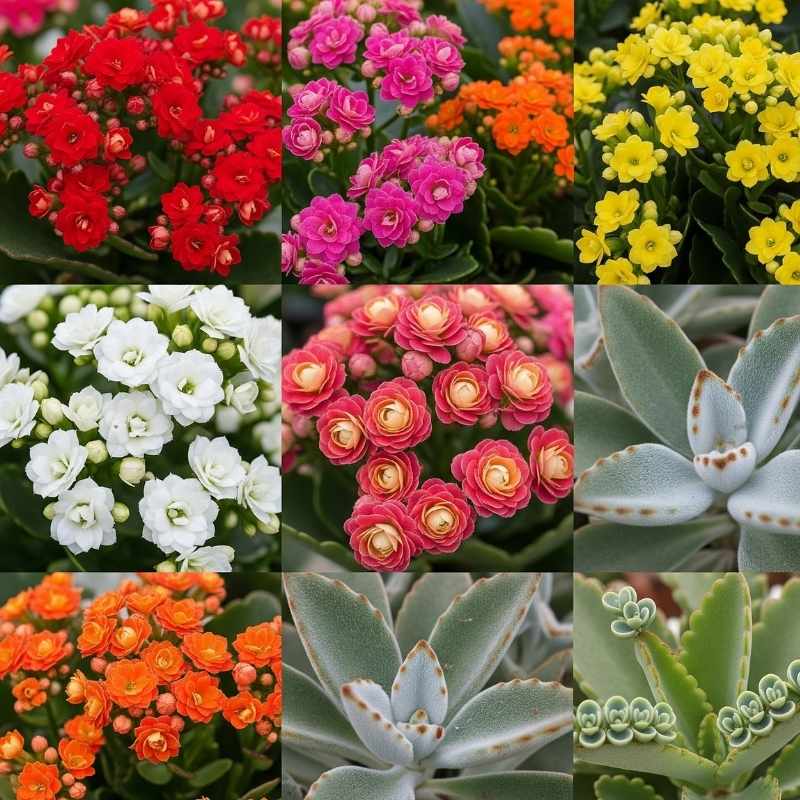
Popular Kalanchoe Types: A Kaleidoscope of Blooms
Most of the Kalanchoes you’ll find for sale are cultivars of Kalanchoe blossfeldiana, bred for their amazing flower colors and forms.
| Type of Kalanchoe | Key Features | Looks Like… |
| ‘Single-Petal’ | Classic four-petal flowers in dense clusters. Wide range of colors. | Small, vibrant stars grouped together. |
| ‘Double-Petal’ | Flowers have multiple layers of petals, creating a rose-like appearance. | Miniature, colorful roses in a bunch! |
| Red, Pink, Orange, Yellow, White Varieties | Bred for specific, intense colors. | A living bouquet that lasts and lasts. |
| Kalanchoe tomentosa (‘Panda Plant’) | Not a flowering type, but known for fuzzy, silvery-green leaves with brown tips. | A soft, cuddly succulent (no bright flowers though!). |
| Kalanchoe daigremontiana (‘Mother of Thousands’) | Recognized for its small plantlets growing along the edges of its leaves. May become invasive when planted outdoors. | Unique leaves with tiny “babies” ready to drop off! |
💡 Great spot for an image! You could add a collage here showing the different vibrant colors of Kalanchoe blossfeldiana, maybe one with single petals and one with double petals.
Flower Looks: Colors, Petal Count, and Bloom Clusters
The leaves of the popular flowering Kalanchoe are usually deep green, thick, and feature a smooth, waxy, succulent texture. You’ll find them with classic single petals or with multiple layers of petals that make them look like tiny roses. What really stands out is how they grow in dense, upright clusters at the tips of the stems, creating a full and impactful display of color.
Leaf Looks: Green, Succulent, and Often Scalloped
The leaves of the common flowering Kalanchoe are generally dark green, uniform in color, thick, and possess a waxy, succulent texture. Many varieties also have a charming, subtly scalloped or wavy edge, adding to their appeal even when not in bloom.
Growth Habit: Compact and Upright
Kalanchoes generally grow as compact, bushy plants. They’re usually sold as small to medium-sized potted plants, perfect for windowsills, desks, or as cheerful centerpieces. Their upright growth habit keeps them tidy and neat.
How Do You Take Care of Your Kalanchoe Plant?
Caring for a Kalanchoe is surprisingly simple, especially since it’s a flowering plant! The main thing to remember is that it’s a succulent at heart.
Kalanchoe Care Summary
Here’s a quick overview of what your Kalanchoe loves:
| Care Category | What Your Kalanchoe Needs |
| Light | Bright, direct sunlight (4-6 hours daily for best blooms!) |
| Watering | Allow soil to dry out completely between waterings; reduce after blooming. |
| Temperature | Warm, 60-85°F (15-29°C); avoid cold drafts. |
| Humidity | Average to low; tolerates typical indoor humidity. |
| Soil | Well-draining, gritty potting mix (like cactus/succulent mix). |
| Pot | Drainage holes are an absolute must! |
| Feeding | Monthly during active growth/blooming with diluted liquid fertilizer. |
| Reblooming | Needs 14-16 hours of uninterrupted darkness for 6-8 weeks. |
The Right Light: Bright Light for Happy Blooms!
This is a super important tip for a Kalanchoe that truly shines: they absolutely need bright, direct sunlight to produce those amazing, long-lasting flowers! Aim for at least 4-6 hours of direct sun a day, ideally from a south or west-facing window. If your Kalanchoe isn’t blooming or looks leggy (stretched out), it’s likely not getting enough light.
Watering Smart: Treat It Like a Succulent!
Because those thick leaves store water, Kalanchoes are very sensitive to overwatering. The most crucial rule: always allow the soil to dry out completely between waterings. When watering, soak the soil thoroughly until excess water drains from the bottom, then allow it to dry completely before watering again. Overwatering is the number one killer of Kalanchoes, leading to mushy leaves and root rot. You can water even less frequently after the plant finishes blooming and during the cooler winter months.
Cozy Temperatures and Dry Air is Fine!
Your Kalanchoe prefers warm temperatures, ideally between 60-85°F (15-29°C). Keep it away from cold drafts from windows or air conditioners, especially in winter. Good news for you: unlike many tropical plants, Kalanchoes are perfectly happy with average indoor humidity – no need for humidifiers here!
Choosing the Right Soil and Pot: Drainage is a Must!
Since they hate wet feet, your Kalanchoe needs super well-draining, gritty potting mix. A cactus and succulent potting mix is absolutely perfect for them. If you’re using regular potting soil, mix in plenty of perlite or sand to ensure excellent drainage. And always, always use a pot with drainage holes! You won’t need to repot them very often, usually only after they’ve finished blooming and if they’re clearly root-bound.
Feeding Your Kalanchoe: Light Meals During Growing Season
To encourage those fantastic blooms, your Kalanchoe will appreciate light feeding during its active growing and blooming season (spring and summer). Use a balanced liquid houseplant fertilizer, or one slightly higher in phosphorus (which helps with flowers), diluted to half strength, about once a month. Once the blooming stops, you can stop feeding entirely.
Encouraging Reblooming: The Secret of Darkness!
Here’s the trick to getting your Kalanchoe to bloom again after its initial show! Kalanchoes are “short-day plants,” meaning they need long periods of uninterrupted darkness to form new flower buds.
- The Secret: Starting in early fall, give your Kalanchoe about 14-16 hours of complete, uninterrupted darkness every day for 6-8 weeks. This means putting it in a closet, under a box, or in a room where no light whatsoever (even a tiny bit from a streetlamp) reaches it during those dark hours. Place it in bright light during the daytime.
- Aftercare: Once you see new buds forming, you can return it to its normal bright-light spot. Don’t forget to deadhead (snip off spent blooms) to encourage more flowers and keep the plant tidy!
What Are Common Problems with Kalanchoe Plants and How to Fix Them?
Kalanchoes are pretty tough, but they will definitely tell you if something’s not quite right. Here’s what to look out for:
Common Kalanchoe Problems & Solutions
| Problem | What It Looks Like | Common Cause(s) | How to Fix |
| Yellowing or Mushy Leaves | Leaves soft, squishy, often yellow | Overwatering (most common), root rot | Stop watering immediately; let soil dry completely; check drainage. |
| No Blooms/Leggy Growth | Not flowering, stems are long/sparse | Not enough light (for initial bloom); not enough darkness (for rebloom) | Move to brighter direct light; apply darkness trick for reblooming. |
| Brown/Crispy Edges/Spots | Dry, brittle spots on leaves | Sunburn (too much direct sun); extreme dryness | Move from harsh direct midday sun; ensure occasional watering (not constantly dry). |
| Drooping Leaves | Leaves look sad, limp | Underwatering (thirsty) OR overwatering (root rot) | Check soil moisture: if dry, water; if soggy, let dry/check roots. |
| Pests | Sticky residue, tiny webs, small bugs | Generally rare, but can occur | Inspect regularly. Treat with insecticidal soap or neem oil. |
| Root Rot | Mushy stems at soil line, foul smell | Persistent overwatering | Prevent with proper watering & drainage. If severe, repot, trim rotten roots. |
Is the Kalanchoe Plant Toxic? Safety for Pets
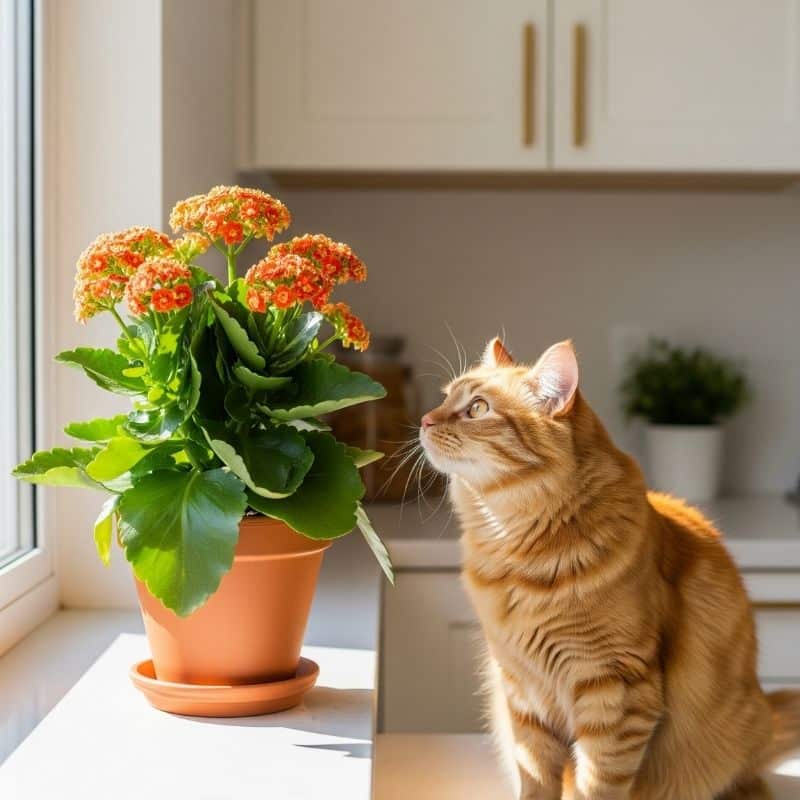
Yes, it’s very important to know: Kalanchoe plants are considered toxic if ingested. They contain compounds called cardiac glycosides, which can affect the heart if consumed in large quantities.
If your cats, dogs, or other pets chew on a Kalanchoe, you might see symptoms like:
- Vomiting and diarrhea: This is the most common immediate reaction.
- Lethargy or weakness: The pet may seem unusually tired.
- Drooling.
- In more severe (and rare) cases with significant ingestion, heart rhythm abnormalities could occur.
While usually not life-threatening unless a large amount is eaten, it can cause significant discomfort. So, it’s highly recommended to keep Kalanchoe plants out of reach of curious pets and small children. If you think your pet has eaten any part of a Kalanchoe and shows symptoms, please contact your veterinarian immediately for advice.
Kalanchoe Plant for Home Decor: Instant Color and Cheerful Vibes
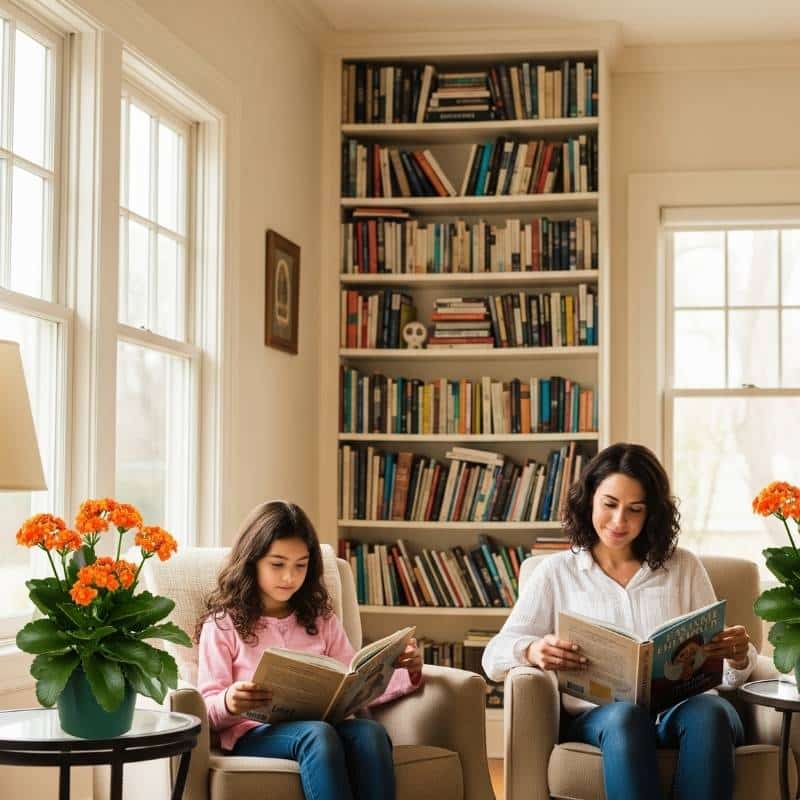
The Kalanchoe plant is a fantastic choice for home decor, bringing immediate color and a happy vibe wherever it goes:
Creating a Bright Pop of Color
Featuring vivid, long-lasting flowers, a Kalanchoe effortlessly brings a lively burst of color to any space. It’s perfect for chasing away those winter blues or celebrating special occasions!
💡 Great spot for an image! You could add a beautiful photo of a Kalanchoe in full bloom, showcasing its cheerful colors.
Perfect for Sunny Spots
Since it absolutely loves bright, direct sunlight, the Kalanchoe is ideal for those sunny windowsills, bright kitchen counters, or well-lit shelves where its colors can truly shine.
Great for Gifts and Seasonal Displays
Kalanchoes are very popular as gifts, especially around holidays like Valentine’s Day, Mother’s Day, or Christmas, thanks to their cheerful appearance and long-lasting flowers. They make wonderful seasonal accents!
Low-Maintenance Bloom Power
Unlike many flowering plants that demand constant attention, the Kalanchoe is a low-maintenance superstar. Its succulent nature means you don’t have to worry about watering it every day, giving you maximum bloom for minimal effort.
The Allure of Kalanchoe Plants: Resilient, Radiant, and Rewarding
The Kalanchoe plant is truly a testament to nature’s cheerfulness and resilience. It offers an unbeatable blend of easy-going care (especially for a flowering plant!), long-lasting, radiant blooms, and a vibrant burst of color. Whether you’re a new plant parent looking for a rewarding flower, or an experienced gardener who appreciates beauty with minimal fuss, the Kalanchoe is a wonderfully rewarding choice. It’s a sunny little reminder that even the driest places can produce breathtaking beauty, bringing warmth and joy into your home.
Frequently Asked Questions (FAQ) About Kalanchoe Plants
Still have some questions about your wonderful Kalanchoe? Here are a few popular options that could be useful to you!
Q1: How often do Kalanchoes bloom?
A1: Kalanchoes (specifically K. blossfeldiana) are often sold in bloom, and these flowers can last for weeks, sometimes even 1-2 months! To get them to rebloom, you’ll need to follow the “darkness trick” (see Q2). With proper care and the darkness treatment, they can bloom multiple times a year.
Q2: How do I get my Kalanchoe to rebloom?
A2: Kalanchoes are “short-day plants,” meaning they need long periods of uninterrupted darkness to set buds. To get it to rebloom, give it about 14-16 hours of complete darkness every day for 6-8 weeks, usually starting in early fall. During the day, give it bright light. Once you see new buds, you can stop the darkness treatment.
Q3: How often should I water a Kalanchoe?
A3: Treat it like a succulent! Let the soil fully dry out before watering again. This could mean watering only every 2-4 weeks, depending on your home’s conditions. It’s much better to underwater slightly than to overwater.
Q4: Why are my Kalanchoe leaves mushy or yellow?
A4: This is almost always a sign of overwatering. The soil is staying too wet, causing the succulent leaves to become waterlogged and the roots to rot. Stop watering immediately, let the soil dry out, and ensure good drainage.
Q5: Do Kalanchoes need direct sun?
A5: For optimal blooms and robust growth, Kalanchoes require several hours of bright, direct sunlight each day, ideally 4 to 6 hours. If they don’t get enough sun, they’ll become leggy and won’t produce many flowers.
Q6: Is the Kalanchoe plant toxic to pets?
A6: Yes, Kalanchoe plants are considered toxic if ingested by cats, dogs, and other pets. These contain substances that may lead to vomiting, diarrhea, and fatigue. In rare, severe cases, heart issues are possible. It’s best to keep them out of reach.
Q7: How long do Kalanchoe flowers last?
A7: One of the best features! Kalanchoe flowers are incredibly long-lasting, often staying vibrant for 6 to 8 weeks, and sometimes even longer, providing continuous color in your home.
Q8: Can I put my Kalanchoe outside?
A8: Yes, in warm weather (above 50°F / 10°C), you can place your Kalanchoe outside in a sunny spot. Just remember to bring it back indoors before temperatures drop in the fall, as it’s not frost-tolerant.
Q9: What’s the difference between Kalanchoe and other succulents?
A9: Kalanchoe is a type of succulent! What makes Kalanchoe blossfeldiana stand out from many other common succulents is its stunning, long-lasting, and vibrant flower display, whereas many other succulents are grown primarily for their unique foliage.

